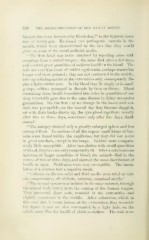Page 286 - My FlipBook
P. 286
258 THE MICRO-ORGANISMS OF THE HUMAN MOUTH.
bacteria Las been furnished by Kreibohm/^- in the hygienic insti-
tute of Gottingen. He found two pathogenic bacteria in the
mouth, wliich were characterized by the fact that they would
grow on none of the usual artificial media.
" The first kind was twice obtained by injecting mice with
scrapings I'rom a coated tongue ; the mice died after a few days,
and showed great quantities of uniform bacilli in the blood. The
rods are \'ery like those of rabbit septicaemia, perhaps somewhat
longer and more pointed ; they are not contracted in the middle,
take up coloring-matter at the extremities only, consequently dis-
play a light central zone. In the blood tlie^' lie singly or in small
groups, seldom arranged in threads by twos or threes. Blood
containing these bacilli inoculated into mice in cpiantities of one
drop invariably gave rise to the same disease in thirty successive
generations. On the first day no change in the inoculated ani-
mals was perceptible, on the second day they became sluggish,
sat with their backs drawn up, the eyes glued together; usually
after two to three days, sometimes only after five days, death
ensued.
" The autopsy showed only a greatly enlarged spleen and less
enlarged liver. In sections of all the organs small heaps of bac-
teria were found within the capillaries, but they did not occur
in great numbers, except in the lungs. Rabbits were compara-
tiveh^ little susceptible. After inoculation with small quantities
of blood, they became only temporarily ill. After a subcutaneous
injection of larger quantities of blood, the animals died in the
course of two or three days, and showed the same distribution of
bacilli as mice. Field-mice were very susceptible. The inocu-
lation of a chicken had a negative result.
" Cultures on diverse solid and fluid media were tried at vari-
ous temperatures; all of them, however, remained sterile."
" The second species was isolated in the same manner, through
the animal body (mice) from the coating of the human tongue.
They presented short rods, rounded at the extremities and
slightly contracted in the middle. After coloration, which in
this case also is more intense at the extremities, they resemble
the figure 8, and are also surrounded by a light halo, on the
whole most like the bacilli of chicken-cholera. The rods were


